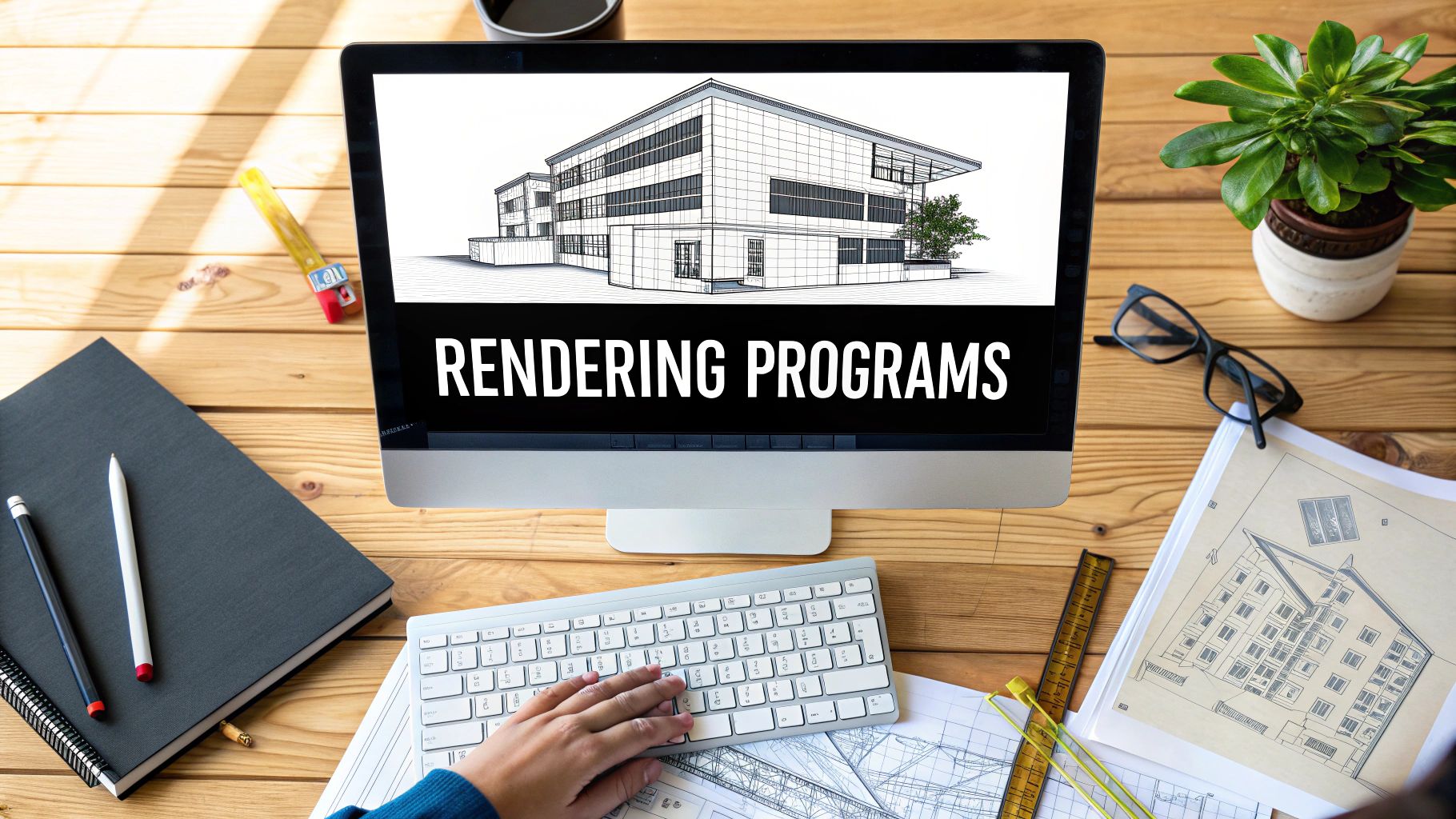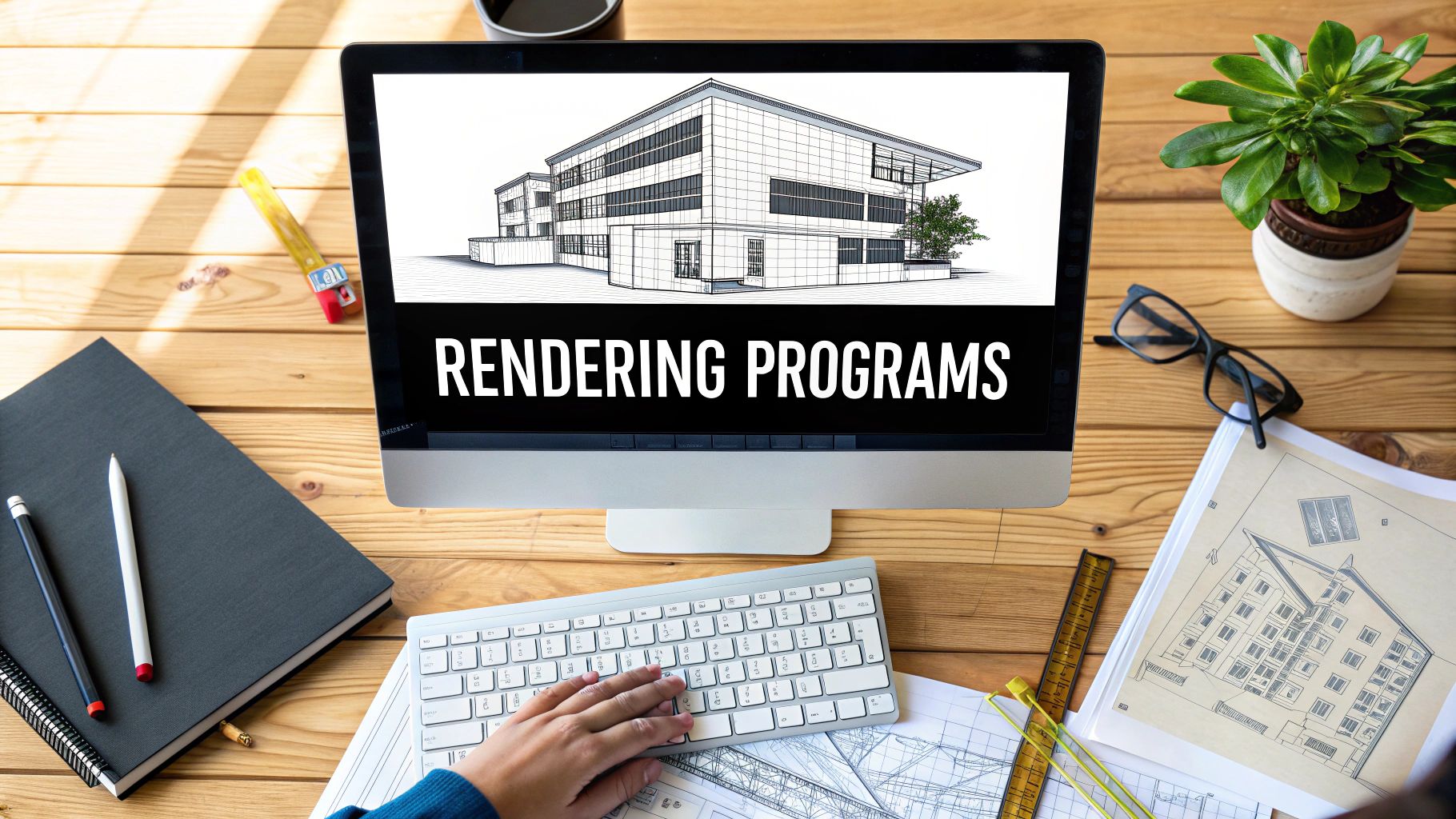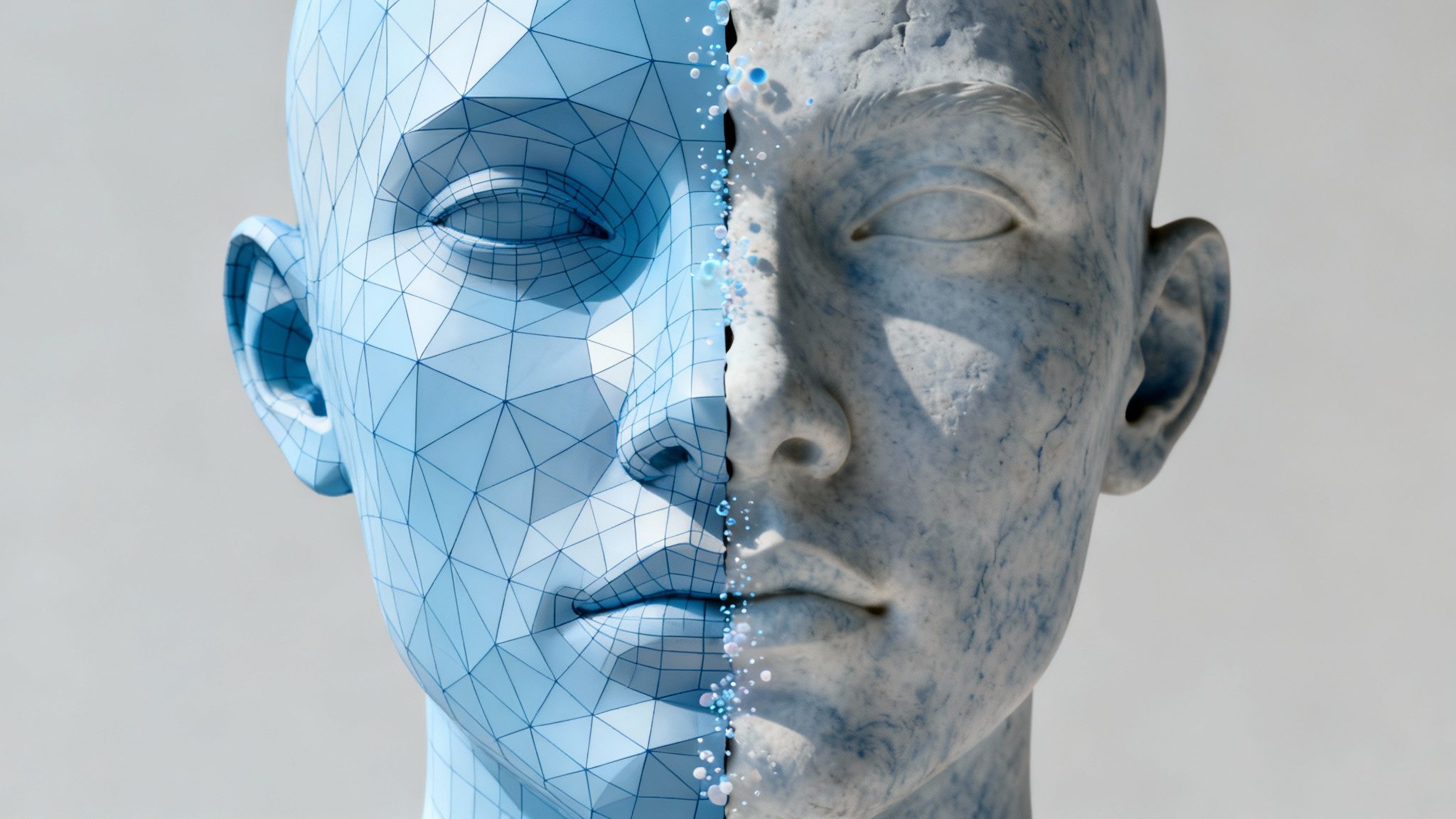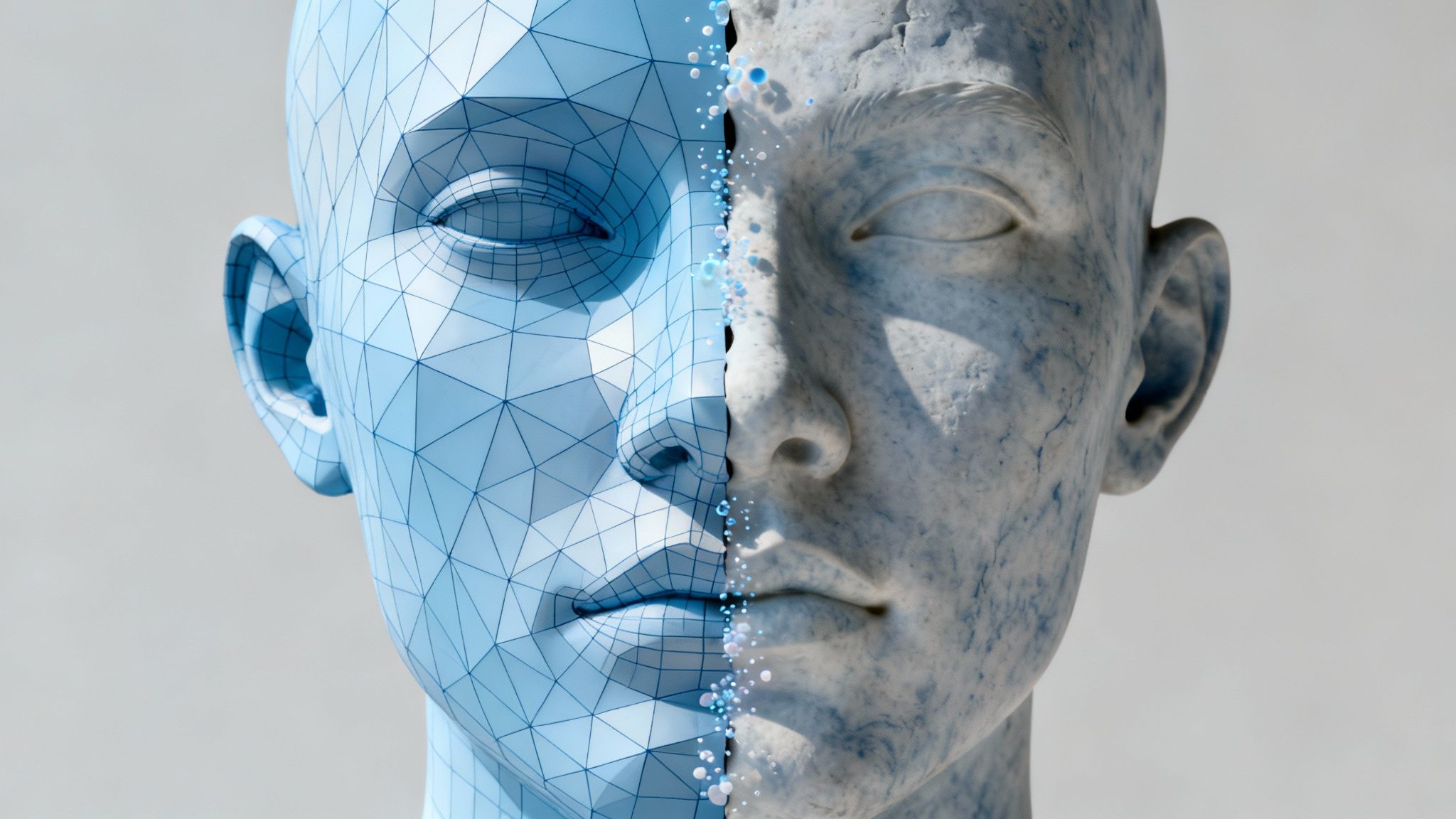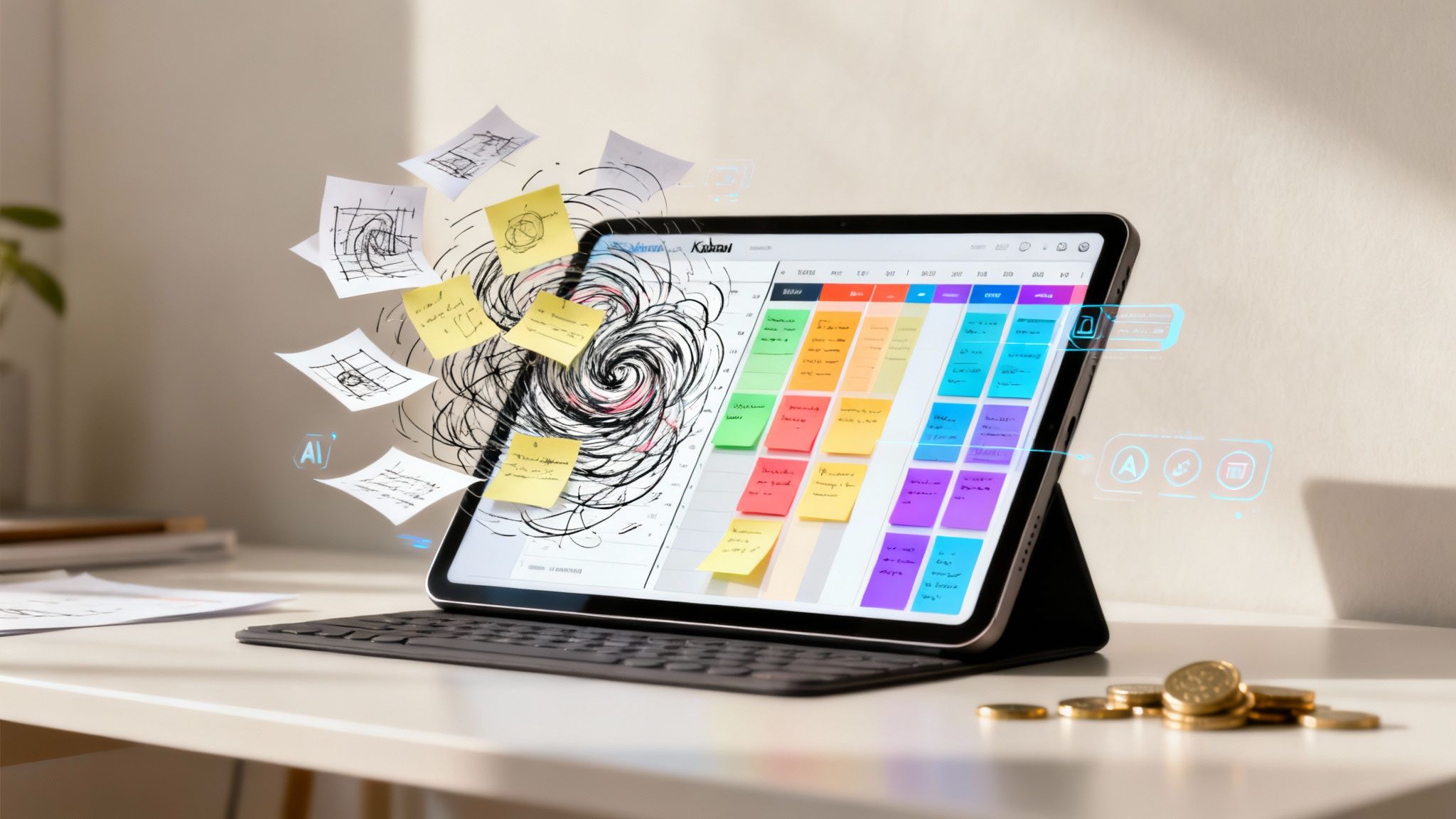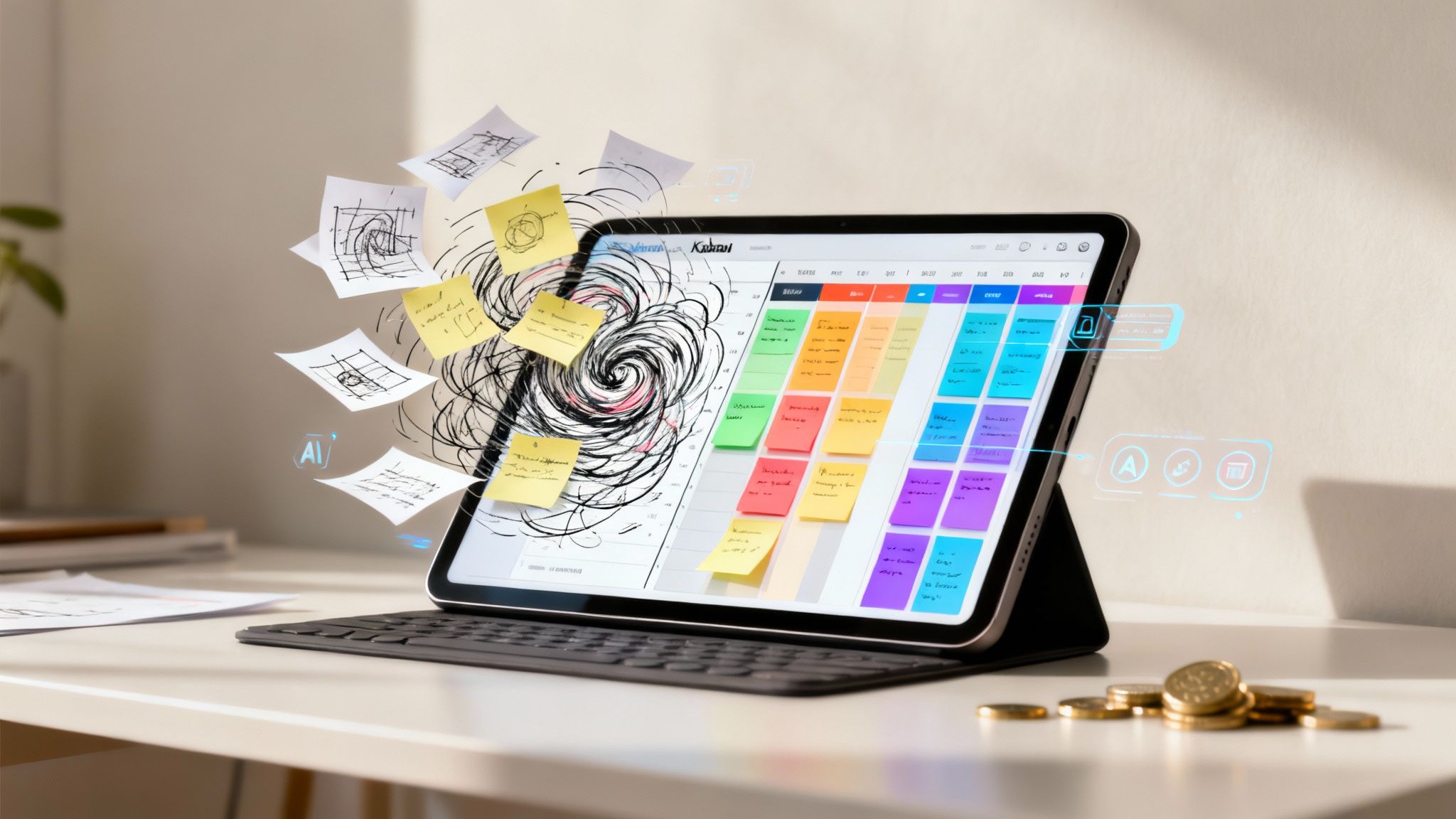At its core, an architectural rendering program is a powerful tool that transforms a technical blueprint into a compelling, lifelike visual. It’s the software that takes a raw 3D model and adds realistic lighting, textures, materials, and atmosphere to create images and animations that are virtually indistinguishable from real photographs.
Bringing Architectural Visions to Life
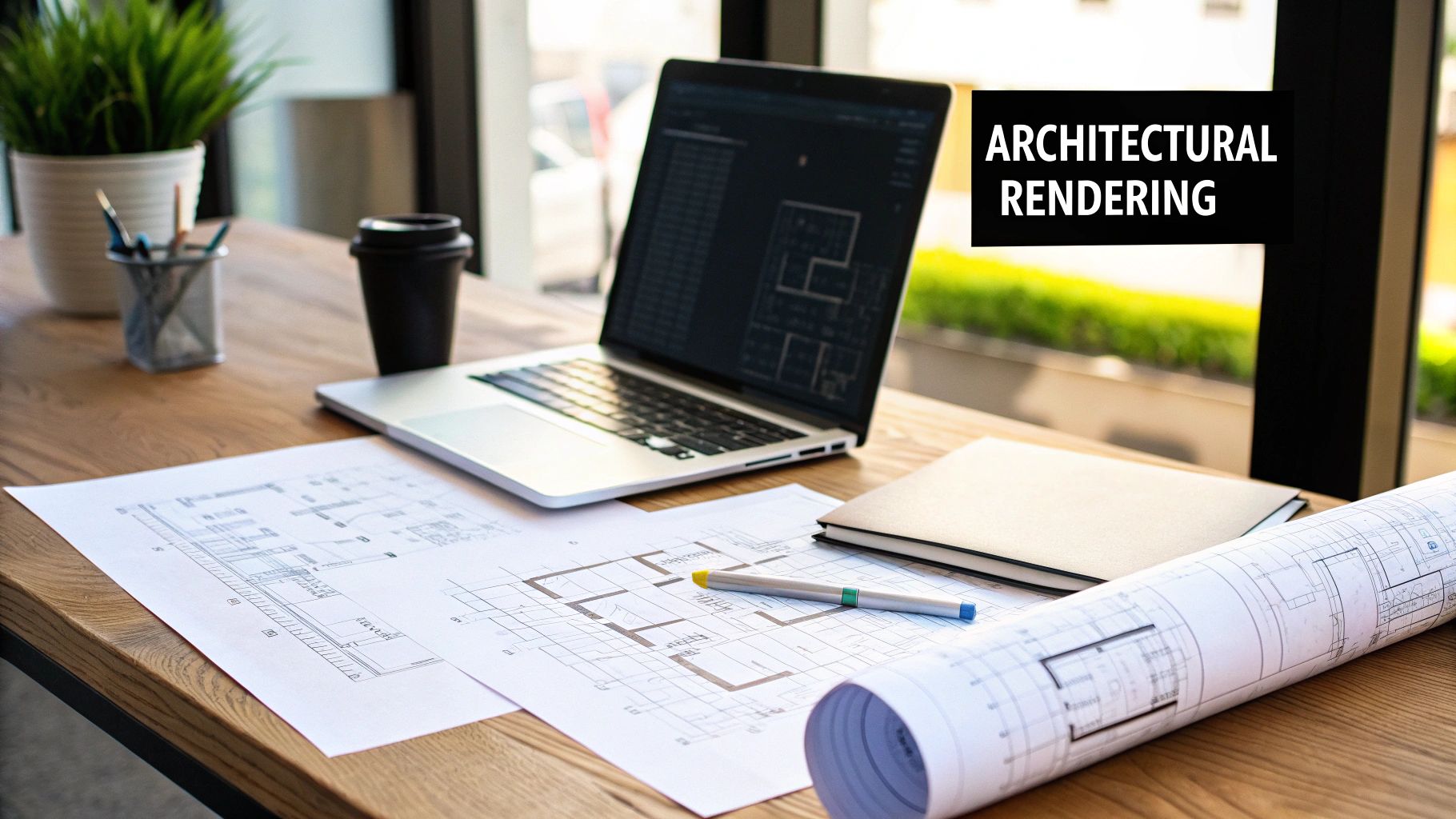
Think of a 3D architectural model like a detailed but unpainted sculpture. It has form, structure, and scale, but it lacks visual character. The rendering program is the professional toolset that meticulously adds the color, texture, and light, transforming that plain sculpture into a clear and compelling work of art.
This technology is no longer a luxury; it has become an essential part of the modern design process for several important reasons:
- Improved Client Communication: Most clients cannot easily interpret technical drawings. Photorealistic visuals bridge that gap, helping stakeholders truly see and understand the design intent.
- Effective Marketing: High-quality renders are invaluable assets for marketing materials. They help communicate a vision and secure project buy-in long before construction begins.
- Informed Decision-Making: Seeing a space in full detail allows teams to identify potential design flaws, test material options, and make confident choices about layouts.
By converting abstract plans into tangible, engaging stories, these programs help teams validate design choices and ensure project alignment. They provide a clear, shared vision for everyone involved, from the architect to the end client.
Ultimately, these programs do more than just create attractive pictures; they build understanding and confidence. To truly bring a vision to life, it’s worth exploring dynamic possibilities, as seen in the importance of 3D animation in architectural design. This is how you create immersive presentations that don't just show a building—they communicate the experience.
Understanding Core Rendering Technologies

Behind every impressive architectural visual is a powerful engine performing complex calculations. The specific technology powering programs for architectural rendering will shape the final image quality, production speed, and the level of interactivity your designs can have.
Two main approaches dominate the industry: real-time rendering and ray tracing.
Consider real-time rendering as an interactive simulation. It's fast, immediate, and allows you to navigate the space and see changes as they happen. This makes it ideal for dynamic client walkthroughs where you’re exploring the design together.
Ray tracing, on the other hand, is like a meticulous studio photoshoot. It carefully calculates the path of every light ray as it bounces around a scene. This is how you achieve hyper-realistic reflections, soft shadows, and complex refractions that look authentic.
Speed Versus Photorealism
What is the trade-off? The decision often comes down to balancing speed against ultimate visual quality.
- Real-time rendering is built for speed. It’s the standard for interactive experiences, VR walkthroughs, and iterating on designs quickly.
- Ray tracing is focused on photorealism. It creates high-impact marketing visuals and competition entries where every pixel matters.
This used to be a difficult choice, but many modern programs now blend both techniques to offer greater flexibility. We’re also seeing a significant shift toward cloud-based rendering solutions that enable teams to collaborate and scale their computing power. This trend is supported by more efficient ray tracing, better integration with BIM tools, and the growing demand for VR presentations.
The core decision is whether your project needs the immediate feedback of a live simulation or the polished perfection of a studio-quality image. Answering this question will guide you to the right software.
Understanding how rendering and animation fit together is also a crucial part of this. The engine you choose will directly impact how efficiently you can produce the animated walkthroughs that bring a space to life.
Essential Features in Rendering Software
When you're selecting a rendering program, it’s easy to be impressed by the final images. But what really matters is the engine and feature set. The best programs for architectural rendering are not just advanced cameras; they are complete digital studios built to improve your workflow and elevate your work.
A comprehensive material library is the foundation. Think of it as your digital sample room, stocked with endless options for wood, concrete, fabric, and glass. The best ones use physically-based rendering (PBR) materials that behave just as they would in the real world, which is a key component for achieving true photorealism.
Just as critical is a powerful lighting system. This lets you define everything from the soft glow of a sunrise to a complex, multi-source interior setup. Good software provides fine-tuned control over sun position, intensity, and even atmospheric haze, so you can set the perfect mood and show clients exactly how a space will feel at any time of day.
Accelerating Your Design Workflow
Beyond the basics, the tools that save you time are what truly separate good programs from great ones. A large asset library is a significant advantage, giving you a drag-and-drop collection of high-quality 3D models—furniture, plants, people, and more. There's no need to model a sofa from scratch when you can pull a suitable one directly into your scene.
The ultimate goal is a seamless workflow. The right software should feel like a natural extension of your design process, not a technical hurdle to overcome.
When evaluating your options, it's helpful to break down what each feature means for your day-to-day work.
Evaluating Architectural Rendering Software Features
Here's a quick look at the core features and why they are so critical for your architectural visualization projects.
Ultimately, these features need to work together to support a fluid creative process.
Finally, you must consider software integration. Any rendering program you choose should integrate well with your existing CAD or BIM software, like Revit or SketchUp. A direct link means that when you adjust the design, the render updates automatically. This keeps everything synchronized and helps avoid version control issues. For any creative team, a smooth workflow is essential, and it's a key part of understanding 3D rendering product development.
Comparing the Top Rendering Programs
Selecting the right program for architectural rendering is like choosing a specialized tool for a workshop. Each one has specific strengths, and the best choice depends on the job at hand. Let's break down the main categories to help you find the right fit for your team's workflow and creative vision.
This infographic provides a high-level overview of a typical workflow, from initial modeling all the way to final post-processing.
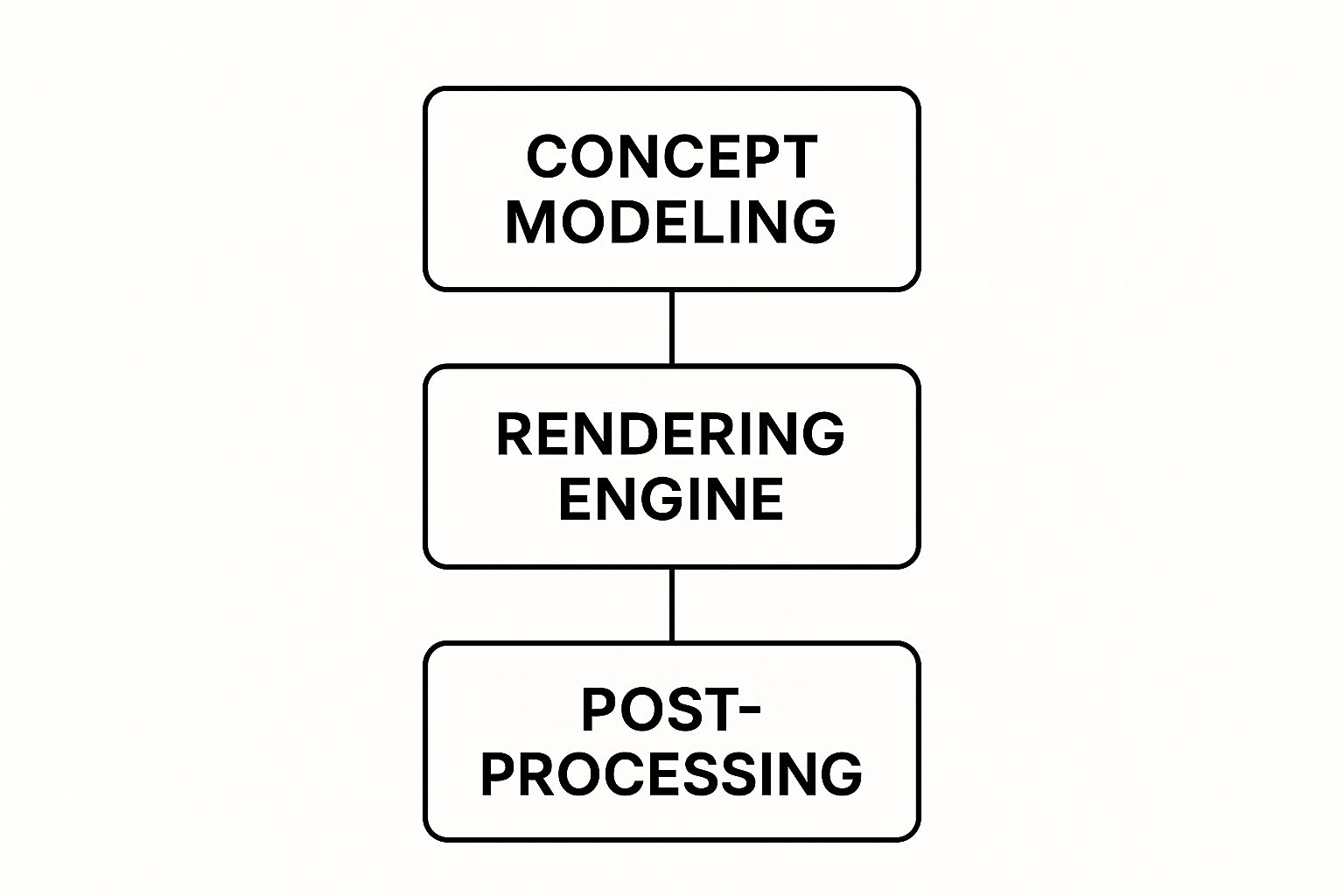
You can see how rendering engines are the critical bridge between a 3D model and a polished visual, and where different tools fit into that process.
Real-Time Rendering Powerhouses
When your team prioritizes speed, interactivity, and ease of use, real-time engines like Lumion and Twinmotion are highly effective solutions. Think of them as a live-action camera for your 3D models. You can make a change and see the result instantly—perfect for client walkthroughs and iterating on design ideas efficiently.
Their biggest advantage? The elimination of long render times. This instant feedback loop allows architects to stay in a creative flow instead of getting bogged down in technical settings, making these tools incredibly accessible even for non-visualization experts.
As you explore the available options, you'll also see advanced tools like the Vibe3D AI platform introducing new approaches. But powerful tools don't always require a large investment. If you're just starting out or working with a tight budget, review our guide on free software for rendering to find some capable alternatives.
Industry-Standard Photorealism
If absolute, uncompromising photorealism is a requirement, then V-Ray and Corona Renderer are the established industry leaders. These are the tools behind high-stakes marketing images and architectural competition entries where every detail must be perfect. They function less like a quick camera and more like a professional photography studio, giving you precise control over light, materials, and atmosphere to create stunningly lifelike results.
All-In-One Modeling and Rendering Suites
Finally, you have the all-in-one solutions like Blender and 3ds Max. These are incredibly powerful applications that handle both 3D modeling and rendering within a single ecosystem. This integrated approach can be a significant time-saver for complex projects, letting you build, texture, light, and render your scene without ever having to switch programs.
So, How Do You Choose the Right Rendering Software?
Selecting the right program isn't about finding the single "best" tool. It’s about finding the best tool for your specific needs. This means looking beyond marketing claims and performing a careful analysis of your actual requirements, goals, and constraints.
It all starts with your projects. Are you producing designs for small residential homes, or are you managing large-scale, complex commercial towers? The scale and detail of your work directly influence the processing power and features you'll need from a rendering engine.
At the same time, you have to consider your team's current workflow. The software you pick should feel like a natural extension of your existing tools, not another technical challenge to manage every day.
The Big Decision Factors
Before you commit to a new subscription or license, review these key areas. A thorough evaluation can save significant time and resources later on.
- Hardware Check: Can your current machines run the software effectively? Some high-end renderers demand significant CPU and GPU power, which could mean an unexpected hardware upgrade you didn't budget for.
- Software Compatibility: Ensure the program integrates well with your primary modeling software, like Revit or SketchUp. A direct, live link is a major efficiency booster—it eliminates version control issues and saves a considerable amount of time.
- Budget and Licensing: Analyze the cost of subscriptions versus perpetual licenses. Subscriptions have a lower upfront cost and ensure you have the latest version, but a one-time perpetual license can sometimes be more cost-effective in the long run.
The market for these tools is growing rapidly. In fact, North America’s 3D rendering and visualization market is projected to reach approximately USD 5.63 billion by 2025, driven by high demand from architects, designers, and engineers. You can explore what's driving this growth by reading these insights about the North American 3D rendering market.
The ideal solution is where your project complexity, hardware, and budget all align with a tool that slots perfectly into your existing design environment. That’s how you get a real return on your investment and provide your team with the creative capabilities they need.
Common Questions We Hear About Rendering Software
When teams begin researching programs for architectural rendering, a few questions frequently arise. Clarifying these points early saves time and ensures everyone is on the same page before committing to a new tool. Let’s address some common points of confusion.
First, the primary question: what’s the difference between 3D modeling and rendering?
Think of it this way: 3D modeling is like building a movie set. You use a program like SketchUp or Revit to construct the digital building, place the furniture, and define all the geometry. It’s the architectural blueprint in 3D.
Rendering is the cinematography. You take that finished 3D model, apply realistic materials (wood, glass, concrete), set up the lighting, and choose your camera angles. The rendering engine then "photographs" that scene to create a polished 2D image or animation. So, modeling is the construction; rendering is the photography.
Do I Need a Supercomputer? What About the Learning Curve?
Another important question is about hardware. Do you need a high-performance machine to get started? Not necessarily. While a powerful computer with a strong CPU and a modern GPU will certainly accelerate the process, it’s not always a day-one requirement. Most programs have quality settings you can adjust to work on a wider range of machines.
For particularly demanding workloads, many firms are now using cloud rendering services. These platforms allow you to upload your project to powerful server farms to perform the calculations for you. It’s an effective way to achieve top-tier results without a large upfront hardware investment.
The time it takes to become proficient with new software is a significant factor. It has to fit your team's skills and your project deadlines.
So, how long does it take to learn these tools? It really depends on the software you choose.
- Beginner-Friendly Tools: Programs like Lumion or Twinmotion are designed for architects, not 3D specialists. Teams can often become productive and produce high-quality work within a few weeks.
- Advanced Engines: On the other hand, mastering a powerful renderer like V-Ray or Corona can take months of dedicated practice. They offer incredible control, but that comes with a much steeper learning curve.
Many successful teams start with a more intuitive tool to establish a solid foundation. Once they are confident, they might graduate to more complex programs for architectural rendering as their projects require it. It’s a practical way to grow your capabilities without overwhelming the team.
At Virtuall, we help creative teams accelerate their 3D workflows with a powerful, AI-driven platform. Transform your ideas from text and images into high-quality 3D models in seconds, manage projects with ease, and foster seamless collaboration. See how you can streamline your creative process by visiting https://virtuall.pro.

